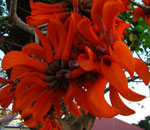Erythrina caffra
Coast
Coral Tree;
Kuskoraalboom (Afrikaans); umSinsi (Zulu); umSintsi (Xhosa)
Article by Geoff Nichols
These trees provide
the illusion of warmth and a
bright splash of colour during the cold drab days of winter. This year
the
trees seem to have outdone themselves. I like to think this is because
of
the exceptionally dry weather we have had along the coast. This is a
coastal species that will not live inland if there is frost.
E. caffra
has more flame orange flowers that are more opened and occurs
in the wild from about East London in the Eastern Cape to about Port
Shepstone. However it has been in cultivation in the Durban area for
generations with some huge specimens in the councillors’ car park at
the Durban City Hall and
on the Esplanade. It is the largest of our coral trees, it has a rough
orangy
grey coloured bark armed with many hooked spines. These spines can also
be
found on the leaves and young stems of this species.
|

|
Pods ripen to a dark brown
colour splitting to expose bright red seeds
that are easy to germinate and grow out to become great garden
subjects. The wood is soft and brittle and when dry makes wonderful
nest
logs for barbets and woodpeckers. If a dead branch remains in the tree
for
longer than a year or two and has holes already bored into the wood
then the
secondary hole nesters like the plum-coloured, black-bellied and Cape
glossy
starlings plus the grey-headed sparrow and maybe if you are lucky a
pair
of red-billed wood hoopoes now know as the green hoopoe, will occupy
the
holes. The range of birds that visit these trees in winter for a meal
of
either nectar, flowers, seeds or insects is staggering. In Durban the
Vervet
Monkeys love the petals and whole troops will feast on these flowers
for
weeks.
During July and August these trees are visited by sunbirds and here in
Durban we have five species: collared, white-bellied, grey, olive,
purple-banded and black sunbirds visiting the flowers.
E. caffra makes a great shaped tree with a dappled shade that allows
you to grow a huge variety of other plants under them. The lichen
covered stems are a great support for growing epiphytic ferns and
orchids. In southern
KZN two species of epiphytic orchid are often found growing on these
trees
they are Mystacidium capense and the winter flowering Mystacidium
venosum.
Both orchids are tiny plants in relation to the tree but when in flower
have
a very pleasing sweet scent at night.
If you trim the lower branches carefully you'll even grow a passable
lawn, but on the other hand who wants lawn when you can have natural
undergrowth! So much better for the wildlife. In a garden design try to
put coral trees in front of a dark background of green the red flowers
then really vibrate with the green and make a doubly spectacular sight.
This is an ideal avenue tree for the entrance into your farm if you
live on the KwaZulu-Natal coast.
